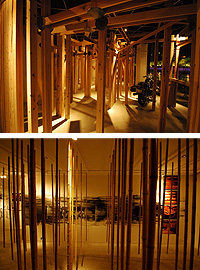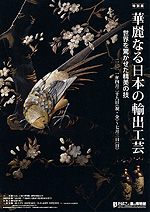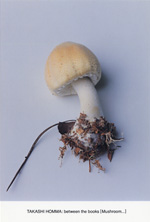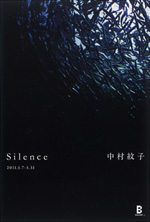 |
Picks is a monthly sampling of Japan's art scene, offering short reviews of exhibitions at museums and galleries in recent weeks, with an emphasis on contemporary art by young artists. |
 |
 |
|
|
 |
 |
 |
 |
| The Five Hundred Arhats |
| 29 April - 3 July 2011 |
Edo-Tokyo Museum
(Tokyo) |
 |
| Originally scheduled to open March 15, this much-anticipated show was delayed six weeks by the March 11 earthquake. In an unprecedented display of all 100 scrolls in the series painted by late-Edo era artist Kano Kazunobu (1816-63) for Tokyo's Zojoji temple, one can practically smell the brimstone wafting from these images of Buddhist hells, replete with karmic fires, hungry ghosts, and bloody corpses. Kano painted it all in loving detail and vivid colors, with some quaint experiments with Western-style perspective and shadowing thrown in for good measure. To see all 100 paintings in one place (and in a very well-arranged installation) is quite simply mind-boggling. |
|
 |
|

|
 |
 |
 |
|
Noi Shigemasa: Creative Works 1978-2011 |
| 26 April - 3 July 2011 |
Nakanoshima Design Museum "de sign de"
(Osaka) |
 |
| This opening exhibition at "de sign de," a new museum in downtown Osaka, features an installation by locally based "spatial designer" Noi. As the show's Japanese subtitle (which translates as "from outside to inside/from inside to outside") suggests, the bamboo and other trees with which Noi has filled the gallery break down the distinction between indoors and outdoors to the extent that the two environments sometimes seem reversed. Perhaps topological play of this sort is precisely what interior design is all about. |
|
|
 |
 |
|
The Splendor of Japanese Export Crafts |
|
|
Tobacco & Salt Museum
(Tokyo) |
 |
| This collection of lacquerware, ceramics and other examples of what the show's subtitle calls "Exquisite Craftsmanship that Amazed the World" is curiously different from the traditional crafts typically displayed in Japanese museums. These are decorative works produced for export, mostly during the Meiji to early Showa periods. While they are indeed Japanese crafts, they were not made for Japanese consumption. The techniques may be traditional, but the flavor they exude is, after all, oddly foreign. |
|
|
|
|
|
|
|

|
 |
 |
|
|
|
|
|
 |
 |
 |
|
|
Takashi Homma: between the books [Mushroom…]
|
|
2 - 15 May 2011
|
LimArt
(Tokyo) |
 |
| Photographer Homma has taken what can only be described as loving portraits of fungi. Each mushroom gets to pose by itself against a white background, with earth and dead leaves still clinging to its mycelia. Shot with meticulous care at artistic angles, Homma's subjects reek of primeval lifeforce -- yet they are cute. Until now this reviewer's favorite Homma series was "Tokyo Willie," which appeared in the magazine S&M Sniper in the 1990s. But these mushrooms are truly his masterwork to date. |
|
|
|
|
|
|
 |
 |
|
|
Ayaco Nakamura: Silence
|
|
7 May - 5 June 2011
|
B Gallery
(Tokyo) |
 |
| Much of the "Silence" series focuses on natural phenomena -- clouds, flowers, schools of fish, ripples in water, birds flying -- but there are also shots of stuffed animals, an old couple on a sightseeing cruise, a sleeping woman. Nakamura's portrait of a newborn baby betrays no hint of its cries or struggles; the scene seems cloaked in a specimen-like silence. The image is a jarring departure from the upbeat, even bubbly style we have come to associate with Nakamura's photography. |
|
 |
 |
 |
|
| Masanori Hata + Saori Hatama |
| 29 April - 4 June 2011 |
artdish
(Tokyo) |
 |
| Hata has created an artificial person, Saori Hatama, a lovely young girl who is a photo-composite of various faces and body parts (some of which appear distinctly male). The resulting images are not merely disturbing, but downright nausea-inducing. Ryuta Aoyagi's accompanying text describes the effect well: "you can't retreat, but you can't come near. She does no harm, and cannot be harmed. That probably causes discomfort. That surely causes discomfort..." |
|
|
|
|
 |
|
|
 |
|